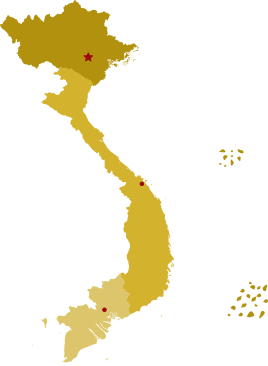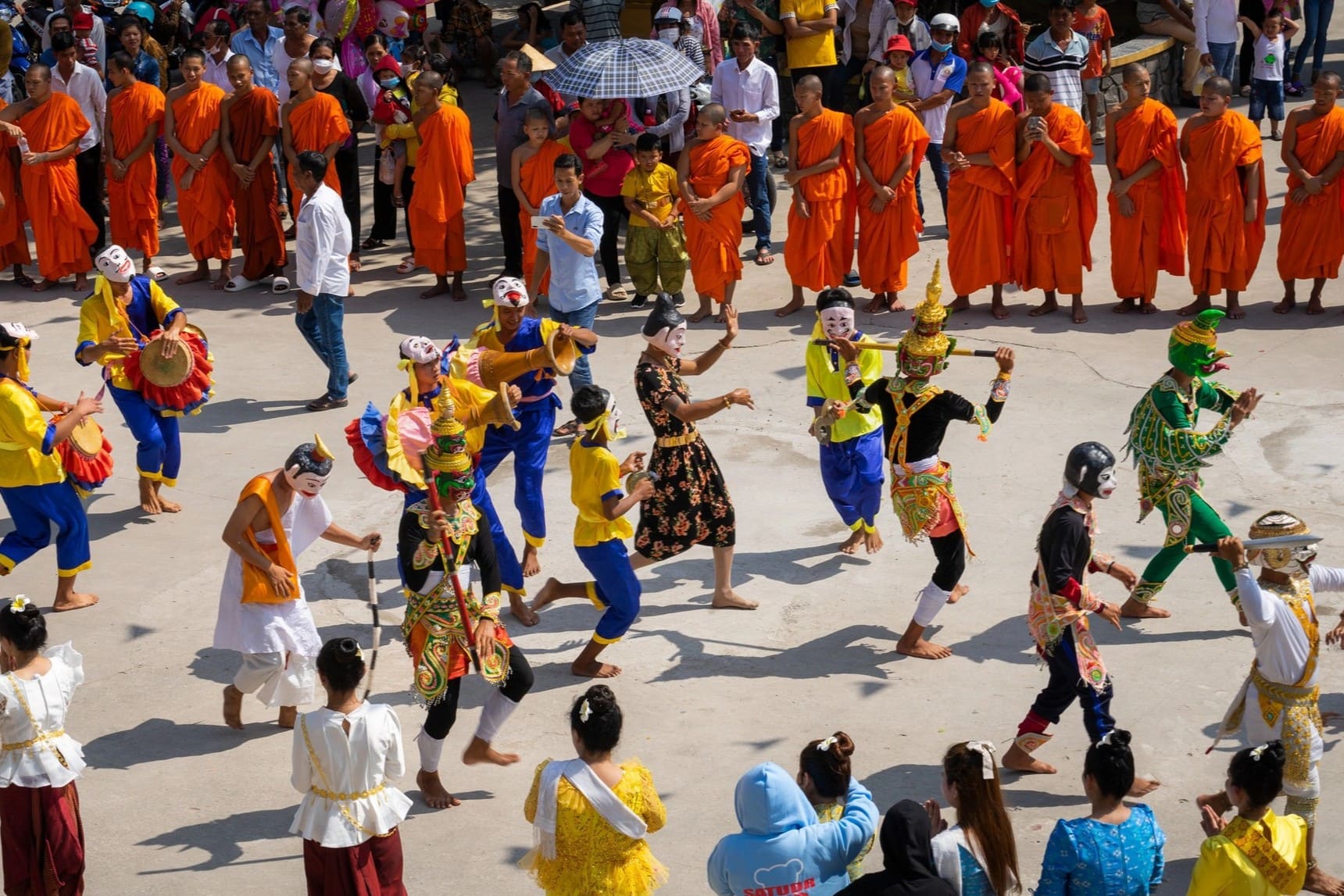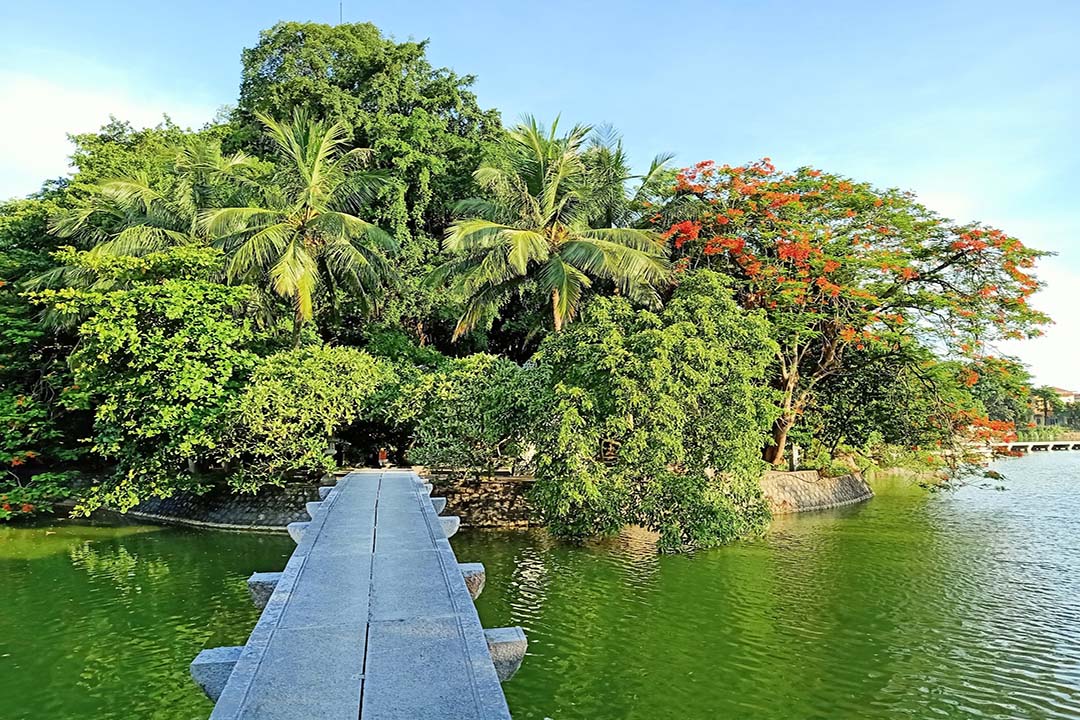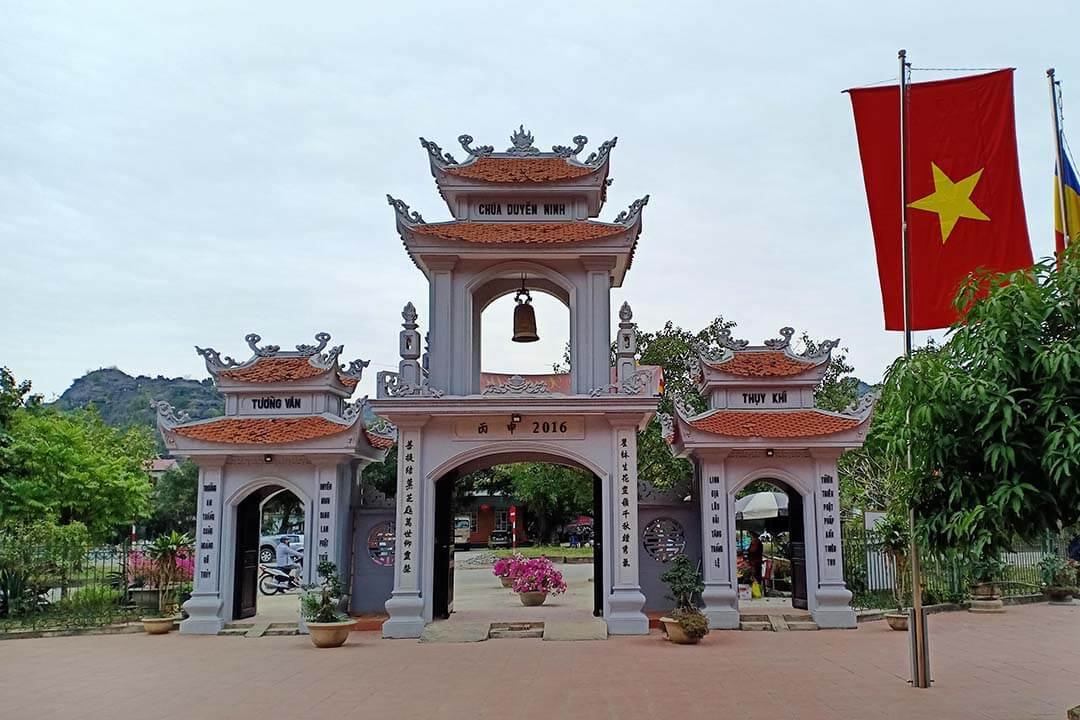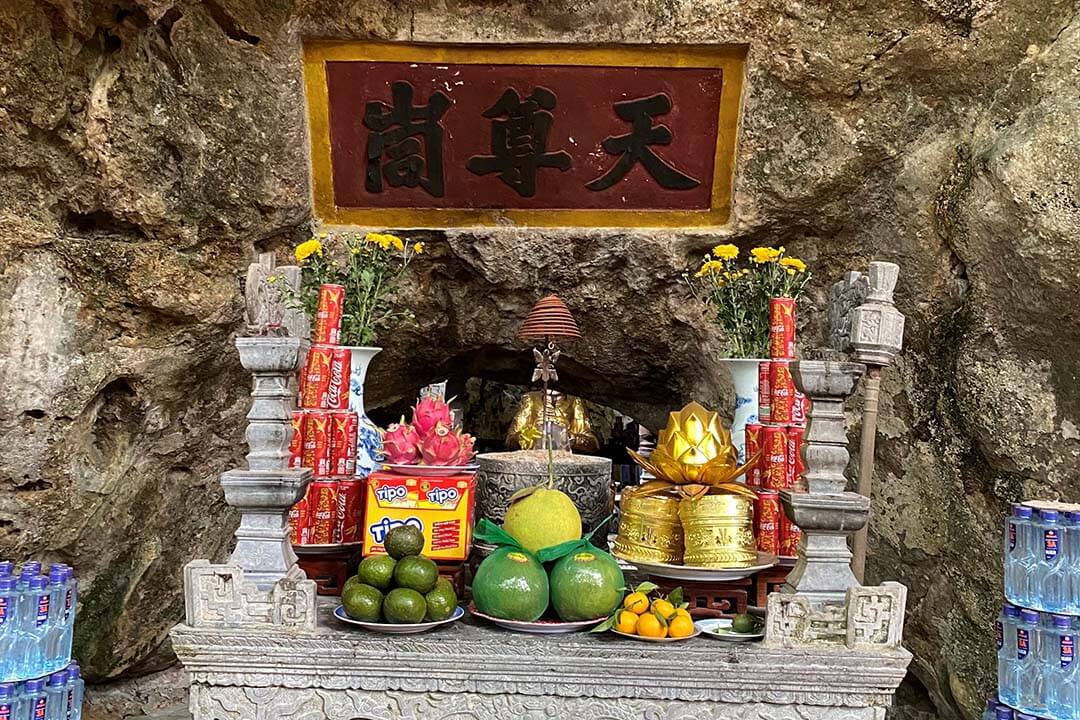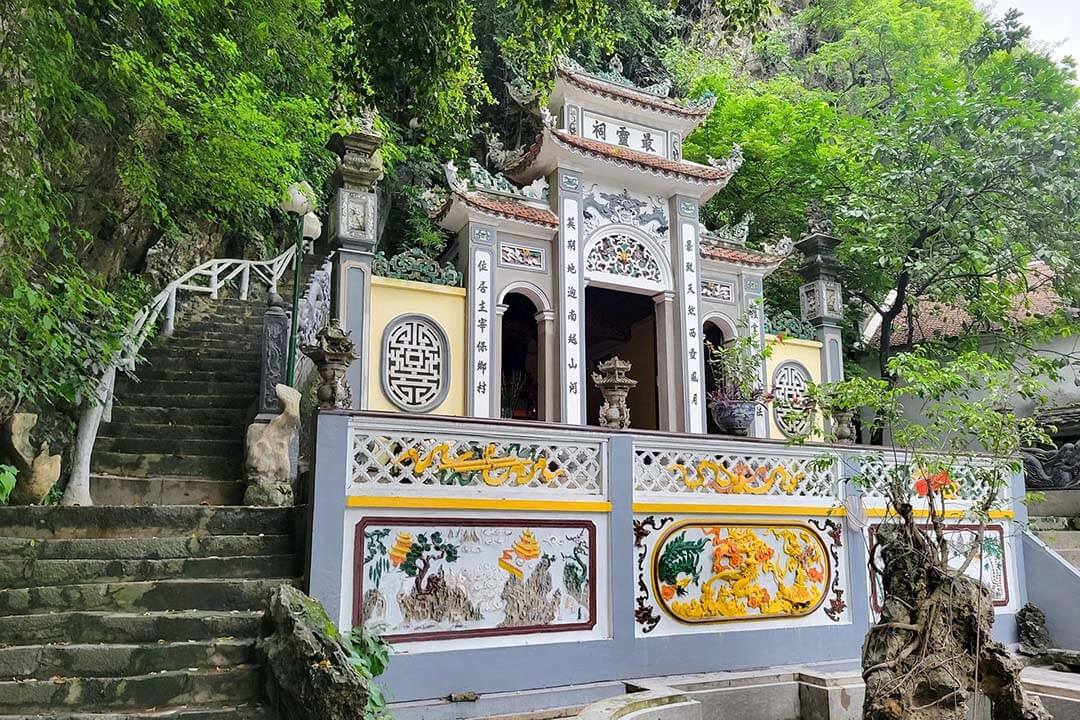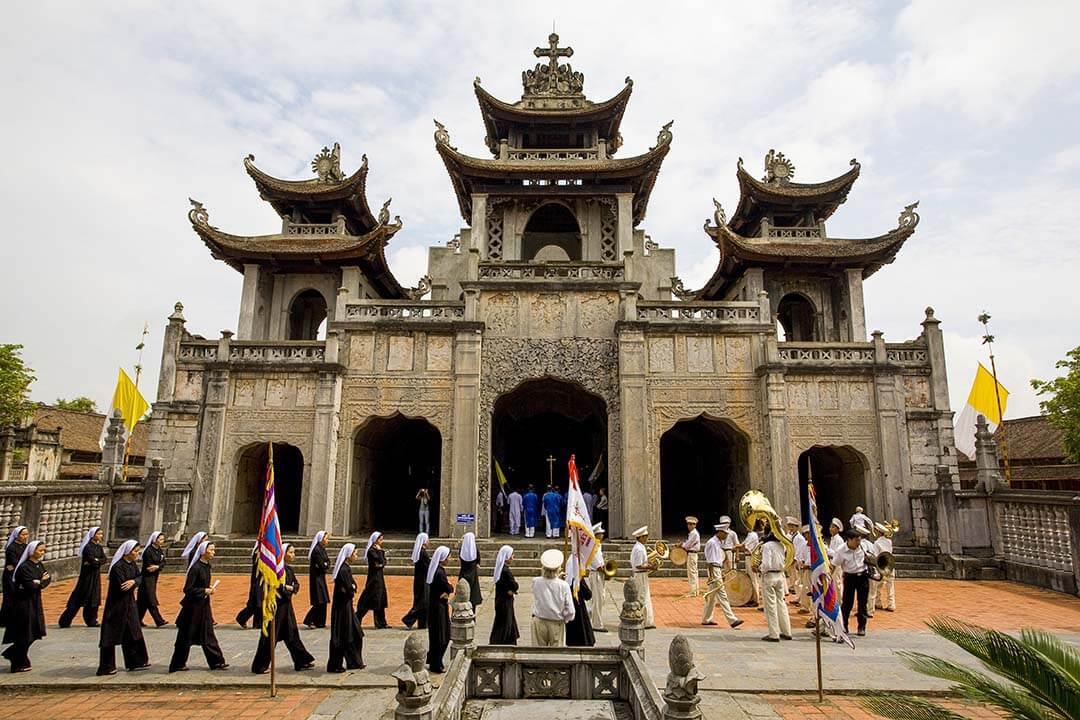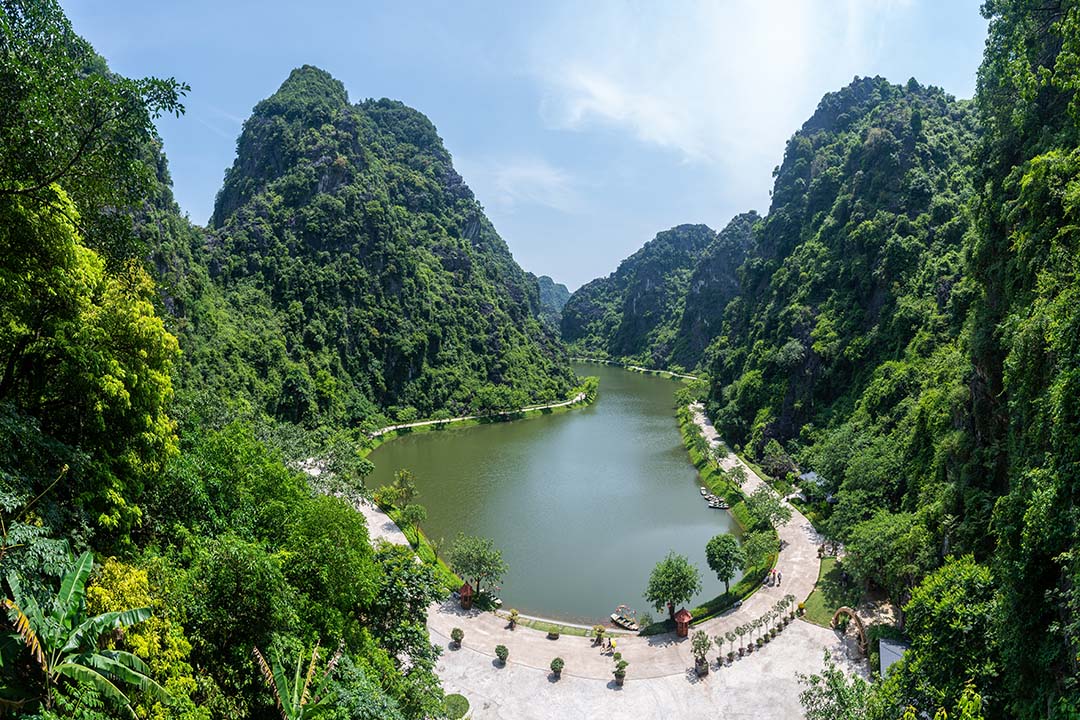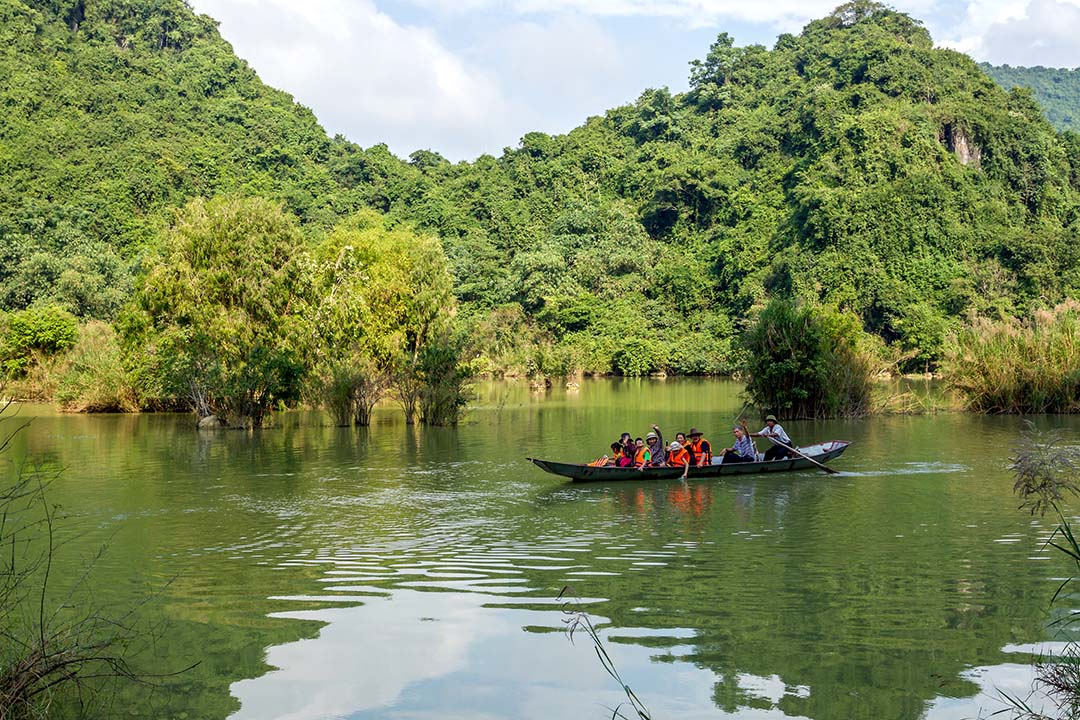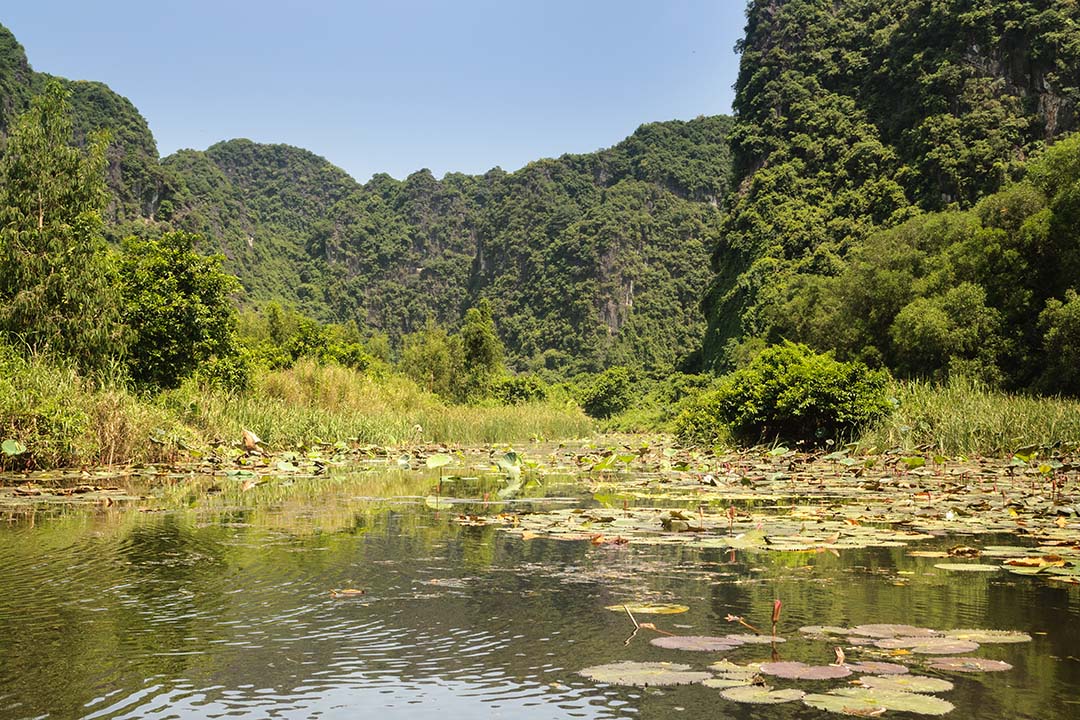Sep - 17 - 2025
Hoa Lu Ancient Capital is located in Ninh Binh province. The ancient capital is a remarkable historical site that offers a glimpse into the nation’s rich heritage. Spanning approximately 300 hectares, it represents the cultural heart of Vietnam, reflecting the early establishment of Dai Co Viet, the first unified state in the region.
Hoa Lu served as Vietnam’s first capital from 968 to 1010, pivotal in forming a centralized feudal state. The ancient capital is recognized as a national cultural heritage site. It serves as the hometown of the national hero Dinh Bo Linh, who is celebrated for his contributions to the unification of Vietnam.
Visiting Hoa Lu ancient capital, you can explore various attractions that highlight its historical and cultural significance. The ancient temples dedicated to the Dinh and early Le dynasties attract history enthusiasts and those interested in Vietnam’s past. The breathtaking natural landscapes surrounding the site combine with historical remnants to create a unique travel experience.
A visit to Hoa Lu Ancient Capital is a must-do in Ninh Binh, it will bring a rich experience that will help you learn the annals of Vietnamese history. Once you’re done exploring the place, you can experience the local cuisine and nearby attractions like Tam Coc and Trang An to further enhance your travel experience. In this article, GTrip will provide complete information about the ancient capital of Hoa Lu
History of Hoa Lu Ancient Capital
Hoa Lu Ancient Capital’s history is deeply intertwined with the rise of Vietnam as a nation and its evolution through various dynasties.
Foundation and significance
Hoa Lu Ancient Capital was founded in 968 by King Dinh Bo Linh. After the king defeated the rebellion of twelve warlords, unified the country, and ascended the throne as the first emperor of Vietnam after a millennium of Northern domination. This marked the beginning of the Dinh Dynasty, which established Hoa Lu as Vietnam’s first capital. Over the next 42 years, it became a significant political center and military stronghold, witnessing the reign of the Dinh Dynasty, the Early Le Dynasty, and the Ly Dynasty.
Transition between dynasties
The transition from the Dinh Dynasty to the Early Le Dynasty occurred after the assassination of Emperor Dinh Tien. His young son, Dinh De Toan, only six years old, ascended the throne amidst turmoil. Utilizing the threat of Song invaders, Queen Mother Duong Van Nga and her court proclaimed Le Hoan as the new emperor, founding the Early Le Dynasty.
Strategic choice of capital
The decision to establish Hoa Lu as the capital was based on its strategic location. According to the Complete Annals of Dai Viet, Dinh Tien Hoang initially chose a narrow piece of land in Dam Thon for the capital. However, due to its vulnerability, he opted for Hoa Lu, which provided better natural defenses.

Welcome gate of Hoa Lu Ancient Capital
Military fortifications
Hoa Lu Ancient Capital was strategically fortified with three significant citadels: the Eastern Citadel, the Western Citadel, and the Southern Citadel (Trang An Citadel). These fortifications were crucial for the political and military security of the region, providing a robust defense against potential invasions and consolidating the power of the ruling dynasties.
- Eastern Citadel
The Eastern Citadel, spanning approximately 140 hectares, was designed with five wall sections that connected the surrounding mountains, creating a formidable defensive structure:
- Section 1: The “East Wall” connects Dam Mountain with Thanh Lau Mountain, measuring 320 meters long.
- Section 2: Extends from Thanh Lau Mountain to Cot Co Mountain, measuring 230 meters.
- Section 3: Connects Cot Co Mountain to Che Mountain, with a length of 300 meters.
- Section 4: Links Che Mountain to Cho Mountain, also measuring 300 meters.
- Section 5: Runs from Ma Yen Mountain to Quan Cave Mountain, covering 200 meters.
The Eastern Citadel served as the daily working place for the Hoa Lu court, underscoring its importance as a political center.
- Western Citadel
Similar in size to the Eastern Citadel, the Western Citadel also covers about 140 hectares and is located in Chi Phong Ancient Village. It features five sections of city walls that connect the mountains:
- Section 1: Connects Ham Sa Mountain to Canh Han Mountain, measuring 100 meters.
- Section 2: Extends from Canh Han Mountain to Hang To Mountain, with a length of 500 meters.
- Section 3: Connects Quen Dot Mountain to Mong Mang Mountain, known as the “Bo Wall”, measuring 150 meters.
- Section 4: Links Mong Mang Mountain to Co Giai Mountain, called the “Bim Wall,” measuring 65 meters.
- Section 5: Features a horizontal inner wall, providing additional fortification.
- Southern Citadel
The Southern Citadel is located south of Hoa Lu and is larger than the other two citadels. Its high mountains and deep, dangerous moats provided a safe and strategic position, protecting the back of the Hoa Lu citadel. This design allowed for rapid movement of soldiers in and out via water routes, enhancing military response capabilities.

Southern citadel at Hoa Lu Acient Capital
Decline and shift to Thang Long
The capital’s importance began to decline when Ly Thai To recognized that Hoa Lu was too narrow for expansion and inadequate for the country’s growing needs. 1010 he proclaimed the capital’s move to Thang Long (modern-day Hanoi). This transition was not merely a shift in location. Still, it marked a significant milestone in Vietnam’s history, laying the foundation for the future capital of Hanoi based on the legacy of Hoa Lu.
Architectural features of Hoa Lu Ancient Capital
Hoa Lu Ancient Capital’s architecture reflects early Vietnamese artistry and spirituality, with temples, palaces, fortifications, and stone carvings that showcase the nation’s royal heritage.
Temples
The temples within Hoa Lu Ancient Capital honor the legacy of Vietnam’s early emperors and showcase traditional Vietnamese architectural styles. Each temple is rich in historical symbolism and reflects the spiritual heritage of the era.
Temple of Emperor Dinh Tien Hoang
The Temple of Emperor Dinh Tien Hoang was built on the original foundation of the ancient Hoa Lu palace. Its main axis facing east represents both domestic and foreign influences, following the traditional Vietnamese architectural style. Ma Yen Mountain, shaped like a saddle, stands in front of the temple and holds the tomb of King Dinh Tien Hoang, reinforcing its symbolic importance.
Temple of Emperor Le Dai Hanh
The Temple of Emperor Le Dai Hanh follows a similar architectural style but on a smaller scale. It is situated near the central square of Hoa Lu, with Den Mountain located on the Sao Khe River. The moat behind the temple serves as a protective boundary. The temple’s entrance, Nghi Mon Ngoai (outer gate), leads along a paved path with symbolic rock formations.
On the left side is a rockery resembling a dancing phoenix, symbolizing grace, while on the right is Tiger Phuc, a rockery formed from an ancient tree over 300 years old. Another rock formation, carved like a “kneeling elephant”, reinforces the spiritual ambiance of the temple.
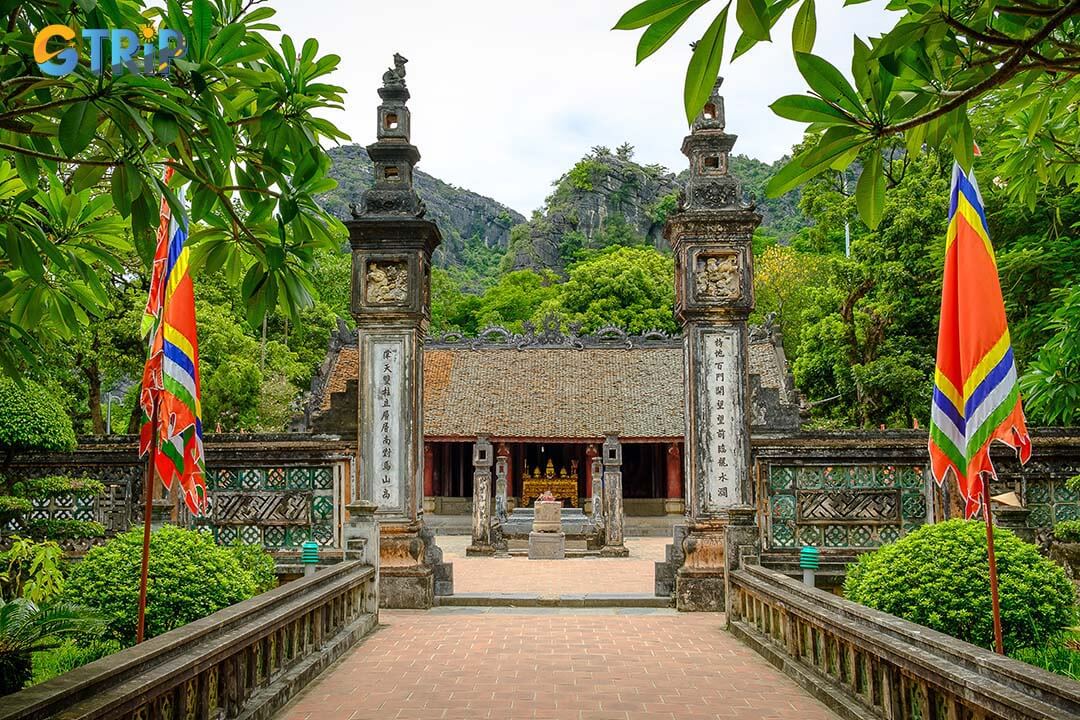
Temple of Emperor Le Dai Hanh
Palaces, fortifications, and city layout
The ancient city of Hoa Lu included a range of 7 palaces, each with a unique purpose and architectural identity:
- Bach Bao Thien Palace: Positioned on Dai Van Mountain, this palace features gold and silver-plated poles, serving as a revered place of worship. It symbolizes the wealth and grandeur of the kingdom.
- Phong Luu Palace: Located to the east, Phong Luu Palace represents refinement and elegance, embodying the court’s aesthetic values and sophisticated culture.
- Tu Hoa Palace: Situated to the west, Tu Hoa Palace embodies harmony, mirroring the balance between nature and architecture.
- Bong Lai Palace: Found on the left side of the complex, Bong Lai adds depth to the layout of the capital and reflects the spiritual elements of early Vietnamese design.
- Pure Land Palace: Positioned on the right side, this palace adds to the symmetrical design, signifying spiritual purity and balance.
- Truong Xuan Palace: Known as the king’s resting place, it provided the ruler with a serene setting, maintaining his connection to the surrounding landscapes.
- Long Loc Palace: Distinguished by its silver-tiled roof, it is next to Truong Xuan, symbolizing prosperity and the continuity of royal legacy.

Palace in Hoa Lu Ancient Capital
Traditional Vietnamese architectural influence
Hoa Lu’s architecture embodies traditional Vietnamese principles of design, blending functionality with symbolic meanings:
- Wooden structures: The buildings and temples were crafted primarily from wood, featuring intricate carvings that highlight the skill of local artisans. These details reflect a harmonious connection with nature and the traditional craftsmanship of the region. These structures also demonstrate the resilience of traditional materials.
- Curved, tiled roofs: The curved eaves and red clay tiles are signature elements of Vietnamese architecture, symbolizing the union of heaven and earth. This design also aids in protection against heavy rains, reflecting practical wisdom.
- Symmetrical layout: The temples and structures of Hoa Lu are arranged symmetrically along a central axis, symbolizing the philosophical balance valued in Vietnamese design. This layout reflects the harmony and equilibrium integral to the country’s cultural and architectural principles. This layout reinforces both visual harmony and spiritual equilibrium.
Spiritual symbolism
The architecture of Hoa Lu is rich in spiritual symbolism, highlighting Vietnam’s reverence for ancestral spirits and natural harmony:
- Dragon and phoenix motifs: Common in temple decorations, these motifs symbolize imperial power, longevity, and prosperity. The dragon, representing the emperor, is balanced by the phoenix, symbolizing grace and peace. Together, they reflect the harmonious balance of strength and beauty valued in Vietnamese culture.
- Yin-Yang symbolism: The layout of the structures reflects the balance of Yin and Yang, harmonizing spiritual and earthly realms. This symbolism is woven into the spatial arrangement, reinforcing the importance of balance and duality in Vietnamese philosophical beliefs.
- Temples dedicated to kings and deities: The temples dedicated to Emperor Dinh and Emperor Le reflect the Vietnamese practice of honoring ancestors and heroes as protectors of the land. These sacred spaces also represent gratitude toward historical figures who contributed to the nation’s unity and strength.
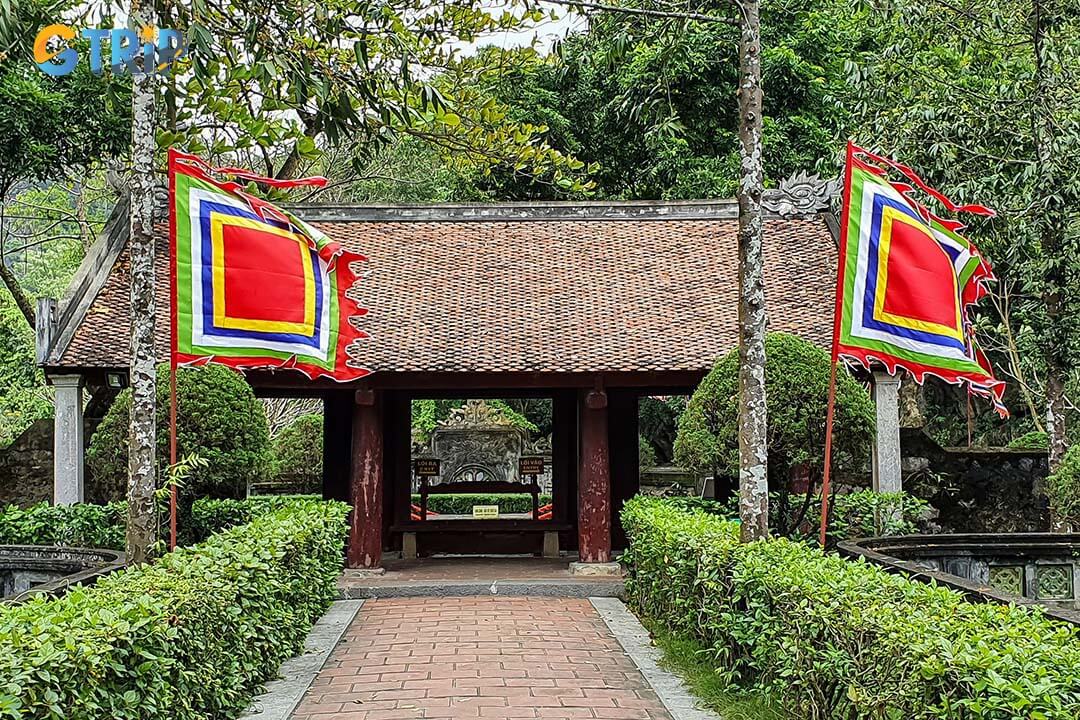
Traditional house at King Dinh Tien Hoang Temple
The natural landscape around Hoa Lu Ancient Capital
The natural landscape surrounding the Hoa Lu ancient capital creates a picturesque and strategic setting that integrates seamlessly with this historical heritage. Majestic karst mountains enclose the former capital with towering peaks and unique rock formations. The Hoang Long River also flows around the area, forming a natural barrier that has protected the capital for centuries.
With its unique topography, Hoa Lu is strategically important in safeguarding the area against potential external threats. The mountain ranges and rivers create natural defensive barriers, enabling ancient dynasties to maintain the nation’s security. This advantage made Hoa Lu an ideal choice for the capital of the early dynasties of Vietnam, significantly shaping the nation’s history.
Furthermore, Hoa Lu is part of the Trang An Landscape Complex, a UNESCO World Heritage site. This connection enhances its cultural significance and attracts numerous visitors to explore the area’s natural beauty and history. The lush valleys, winding rivers, and fascinating limestone formations create a stunning tableau that contributes to the ecological richness and diversity of the landscape.
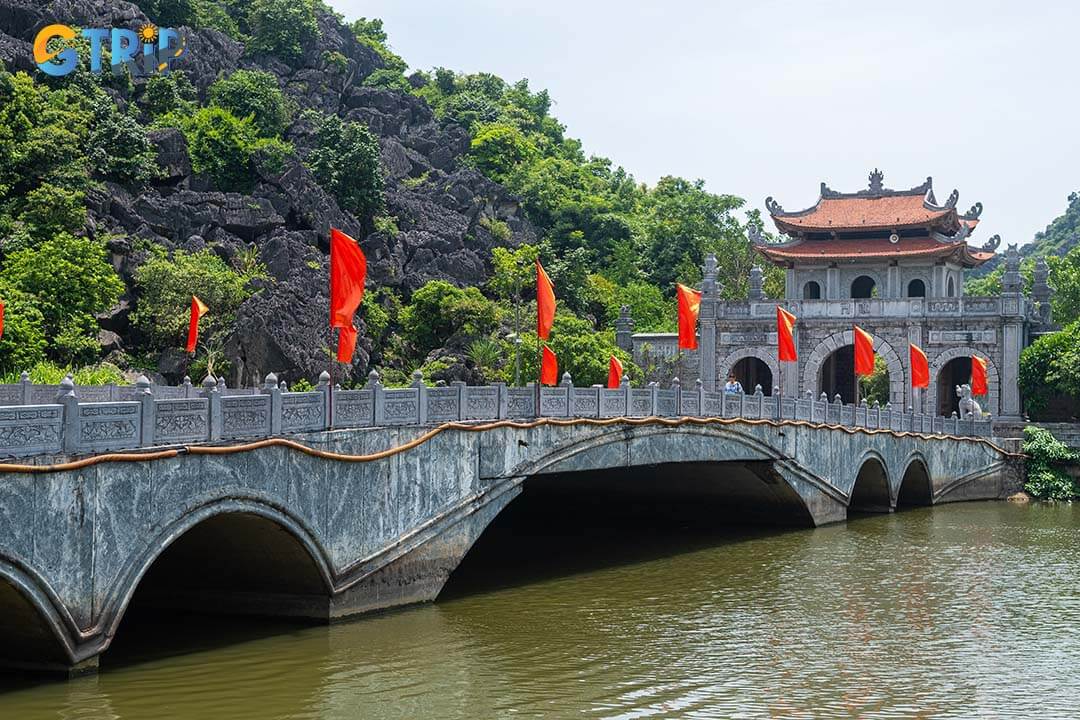
Image of the bridge connecting the gate of Hoa Lu Ancient Capital to the palace inside
What to see and do at Hoa Lu Ancient Capital
Hoa Lu Ancient Capital showcases Vietnam’s history with its monuments and temples. You can enjoy local folklore and adventure activities like hiking and cave exploration, immersing themselves in the region’s rich culture.
Visit King Dinh Tien Hoang and King Ly Thai To temples
At the King Dinh Tien Hoang Temple, we visited and paid respects at the shrine honoring the king’s contributions to Vietnamese history. The temple houses many historical relics and ancient treasures, allowing visitors to learn about the legacy of King Dinh Tien Hoang. This temple holds spiritual value and symbolizes the early period of nation-building, reflecting the legends and achievements of a great king.
Nearby, the King Ly Thai To Temple is an essential destination where you can honor the king who played a crucial role in shaping the nation. The King Ly Thai To Temple is distinguished by its ancient architecture and carefully preserved historical artifacts. Notably, the King Dinh Temple and the King Ly Temple are ranked among the “Top 100 famous 100-year-old works in Vietnam”, highlighting their importance in Vietnamese cultural heritage.
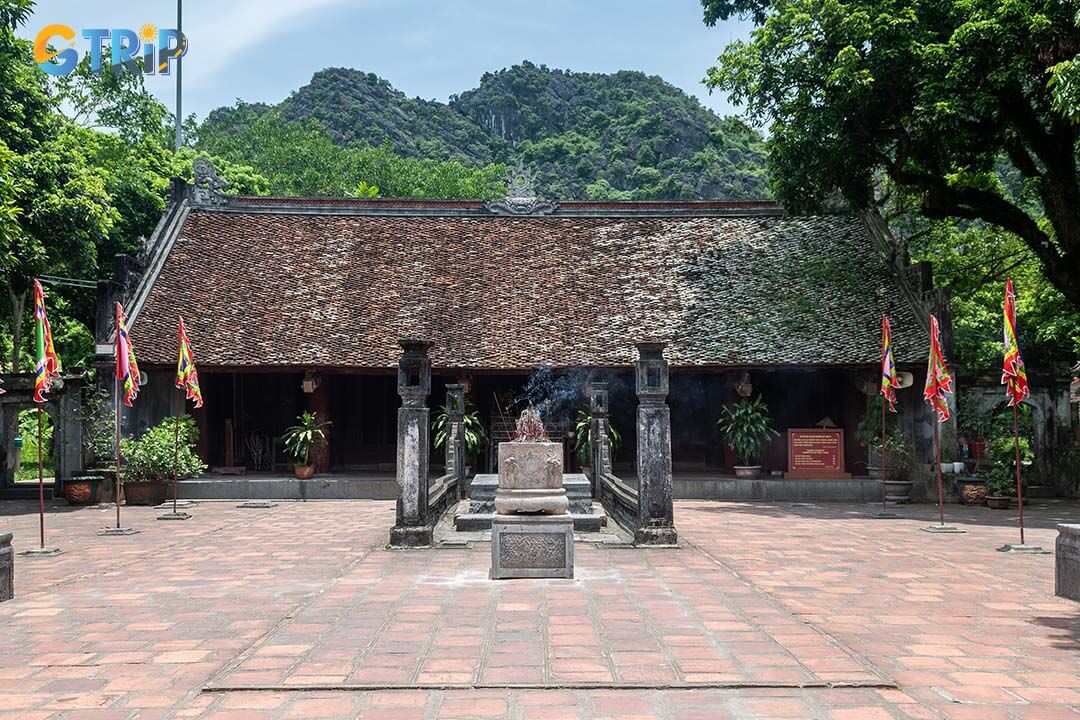
Views of temple at Hoa Lu Ancient Capital
Participate in the annual festivals
Participate in the vibrant annual festivals held in Hoa Lu, where you can enjoy and celebrate the local culture through various performances and traditional customs. These cultural festivals are a perfect opportunity to witness the rich traditions of this land. Some notable festivals include:
- The offering ceremony at the Tran Temple in the Trang An tourist area commemorates the deity Quy Minh in Nam Hoa Lu Town. This festival expresses gratitude to the Holy Quy Minh Dai Vuong on the 18th day of the third lunar month each year.
- The Dinh Bo Linh Temple Festival in the hometown of Gia Phuong Commune. This festival takes place on the 9th and 10th days of the third lunar month to honor and preserve the significant contributions of the first emperor of Vietnam after the Northern domination, who laid the foundation for the first centralized feudal state in Vietnam.
- The Hoa Lu Cave Festival is held on the 10th day of the first lunar month to commemorate Dinh Bo Linh and the deity Khong Lo Minh Khong of the four towns of north Hoa Lu.
- The Nhat Tru Pagoda Festival takes place in early March along with eight other ancient pagodas in Hoa Lu. Every year, on the 15th day of the first lunar month, the pagoda hosts the dragon boat procession, a ceremony to pray for the nation’s peace and prosperity.
- The Bai Dinh Pagoda Festival occurs from the afternoon of the first day of the Lunar New Year until the sixth day, continuing throughout the entire month of March in the lunar calendar. This festival is an occasion for the people to honor Saint Nguyen and the deity Cao Son of West Hoa Lu Town.
- The Kim Ngan Pagoda Festival is organized on the full moon of the first lunar month, which includes a ritual of carrying the dragon boat from the pagoda to the Bo De River (Sao Khe). This festival combines Buddhist and folk beliefs, symbolizing a wish for good fortune, favorable weather, and abundant harvests.
- The Thien Ton Cave Festival usually takes place on the 4th day of the third lunar month to commemorate the deity Thien Ton in East Hoa Lu Town.
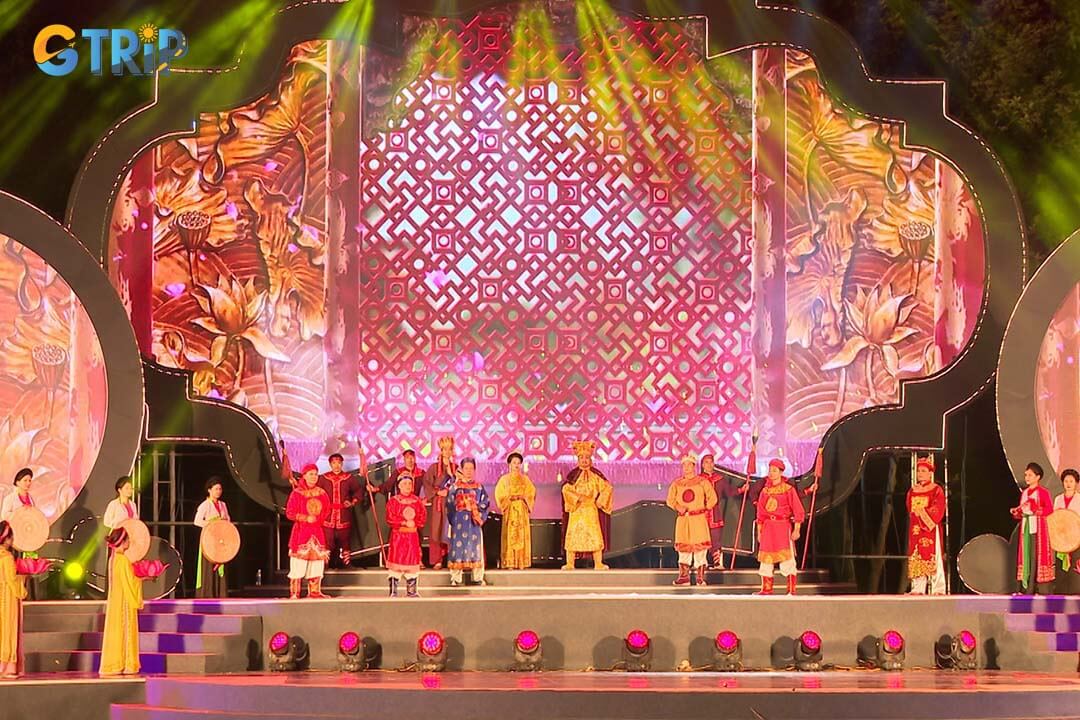
Anual Bai Dinh Pagoda Festival
Explore the surrounding caves and mountain paths
In and around Hoa Lu, you can discover various captivating natural and cultural sites, from ancient caves with archaeological significance to scenic mountain paths offering stunning views.
Muoi Cave
The historical site of Muoi Cave is located within the Hoa Lu Ancient Capital Cultural and Historical Complex in Truong Yen Commune, Hoa Lu District, Ninh Binh Province. According to legend, Muoi Cave lies within the eastern part of the ancient Hoa Lu Capital. It was once a critical site safeguarded by the Dinh dynasty for storing salt and provisions, hence its name, Muoi Cave.
Recognized as a geological heritage site, Muoi Cave is situated within the core zone of the Trang An Scenic Landscape Complex, a UNESCO World Cultural and Natural Heritage Site. During wartime, it served as a military food storage depot. Today, the Ministry of National Defense manages and protects Muoi Cave for national security and defense purposes.

Muoi Cave lies within the eastern part of the Hoa Lu Ancient Capital
Luon Cave
Luon Cave, one of the prominent attractions in the Trang An Scenic Landscape Complex in Ninh Binh, is a breathtaking natural cave nestled amid towering cliffs and lush forests. It spans approximately 250 meters in length and 10 meters in height, featuring unique stalactites and stalagmites that create a mesmerizing, dreamlike atmosphere. Upon visiting and exploring the cave, travelers experience tranquil, serene surroundings and fresh cave air.
One special feature of Luon Cave is that visitors can independently paddle through on kayaks, adding an exciting and novel dimension to their journey. The area also serves as an ideal photo spot, with scenic natural views. Luon Cave is perfect for nature enthusiasts and offers a cultural experience to explore the history and heritage of Ninh Binh.

View under Luon Cave
Hoang Long River
The Hoang Long River, a stunning river in Ninh Binh, is known for its clear waters and beautiful scenery. Stretching about 25 km and around 300 meters wide, it flows through rice fields and majestic mountains, creating a serene landscape. The river is also significant for its historical ties to King Dinh Tien Hoang and the Dinh dynasty.
Along the banks of Hoang Long River, travelers can engage in various activities, including boating, sightseeing, and exploring ancient pagodas. The river is a crucial water source and a historical repository that reflects the culture of the local people. When you arrive at Hoang Long River, you are immersed in a serene ambiance and can learn about the legends and myths of this historic river.

The festival in Hoang Long River
Sao Khe River
Sao Khe River, a tributary of the Hoang Long River, is one of the prominent rivers in Ninh Binh, flowing through the Trang An World Heritage area. With a length of about 20 km, it boasts pristine waters meandering between imposing limestone mountains. Besides its breathtaking natural beauty, the river holds significant cultural and historical value, tied to legends and key sites like the ancient Hoa Lu Capital.
On both sides of Sao Khe River, you can admire stunning natural scenery, bask in the fresh air, and partake in activities such as boating and sightseeing. This spot is also an ideal stop for learning about the history and culture of Ninh Binh, from ancient legends to remarkable cultural heritage. Sao Khe River is not only a peaceful waterway but also a place that preserves the memories and myths of this land.
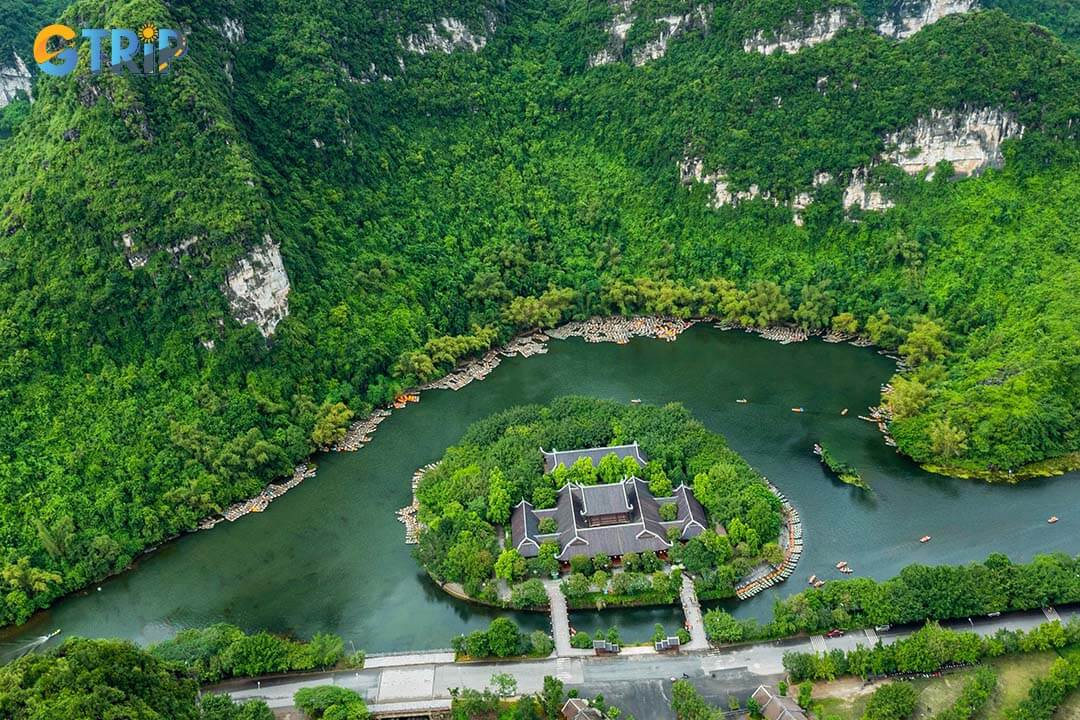
Aerial view of Sao Khe River
Non Nuoc Mountain
Non Nuoc Mountain, a remarkable peak near Ninh Binh’s city center, captivates visitors with its majestic beauty and rich cultural significance. Rising to about 200 meters, the mountain is covered in lush vegetation, creating a beautiful natural landscape. It is also well-known for the classical poems that echo people’s feelings and emotions for their homeland, offering visitors a profound experience upon visiting.
Non Nuoc Mountain boasts beautiful scenery alongside rich historical and cultural relics, attracting explorers and learners. The peak offers stunning views of Ninh Binh, including the winding Hoang Long River and lush green fields. It’s a perfect destination for nature lovers to reconnect with the region’s heritage, promising memorable experiences.
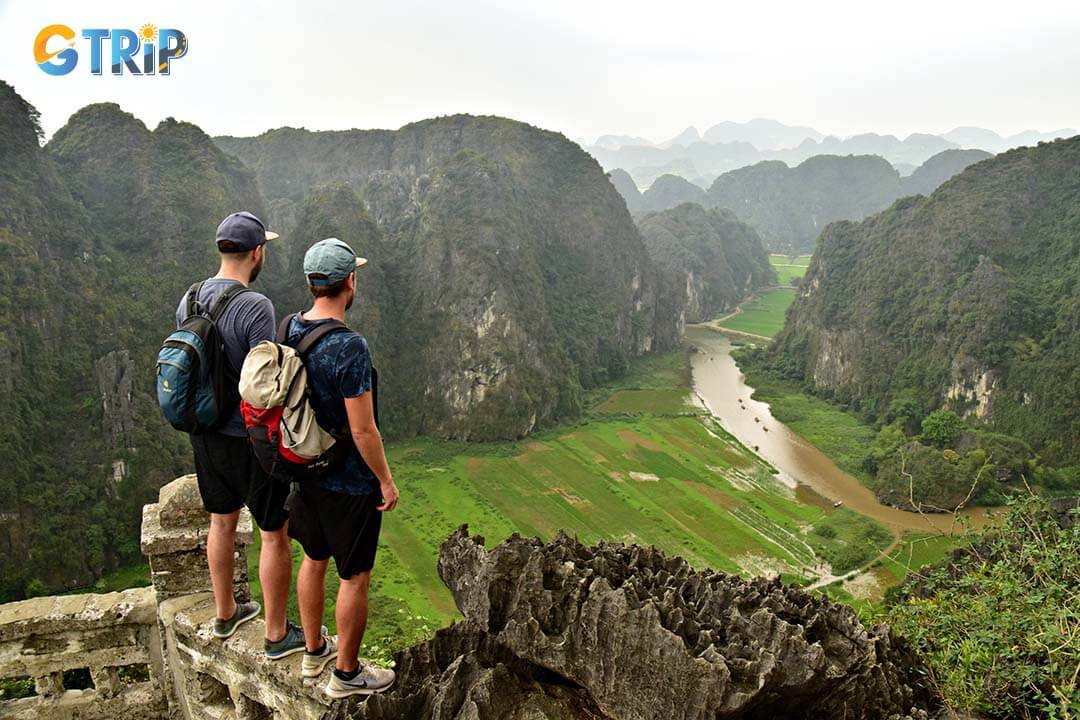
View seen from Non Nuoc Mountain
Ma Yen Mountain
Ma Yen Mountain, in the Hoa Lu Ancient Capital Complex, is notable for its saddle-like shape and historical significance. It’s linked to King Dinh Tien Hoang, who established the Dinh dynasty capital here in the 10th century. Ma Yen is a captivating natural landmark with its striking beauty and rich history.
Reaching the summit, you are rewarded with a panoramic view of the Hoa Lu ancient capital, with temples, tombs, and overlapping mountain ranges in sight. Standing atop Ma Yen, one felt the grandeur of nature and was transported back to the era of national pride and courage. Ma Yen Mountain is more than a natural attraction; it is a cultural and historical emblem, bringing you back to the country’s heroic past.
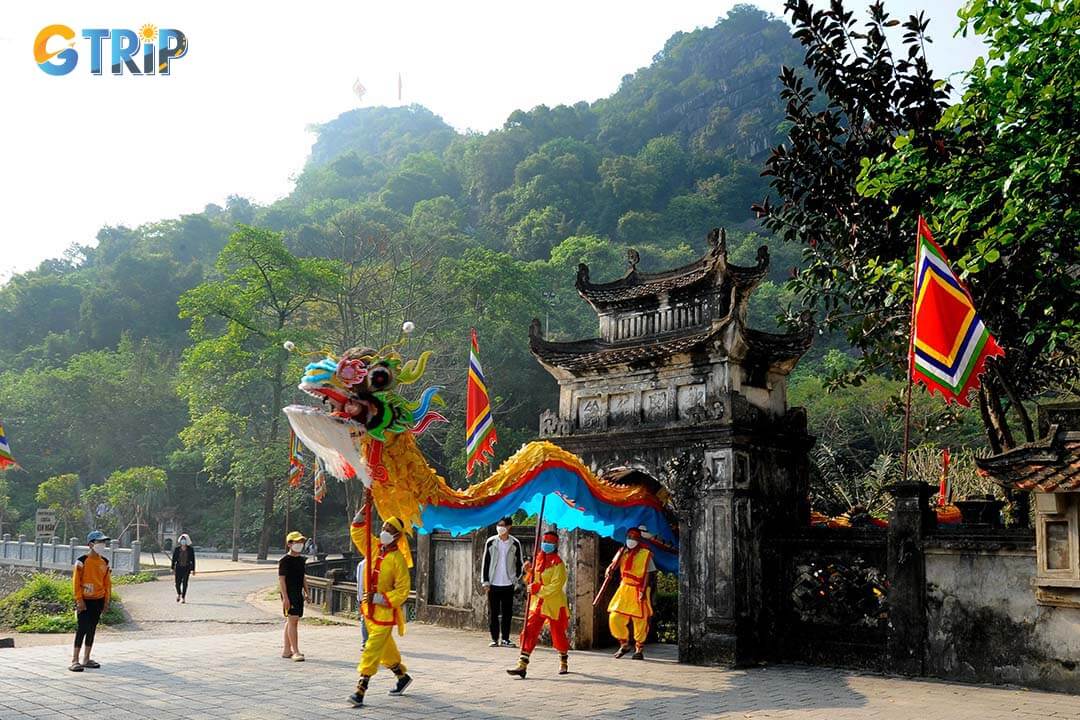
Festival in the Hoa Lu Ancient Capital
Cai Ha Mountain
Cai Ha Mountain is among the prominent landscapes in Ninh Binh, located within the Trang An Scenic Landscape Complex – a UNESCO World Heritage Site. Surrounded by towering limestone cliffs and lush vegetation, Cai Ha Mountain has a raw, majestic beauty, capturing the essence of nature.
At the mountain’s base are vast rice fields, creating a sense of tranquility and harmony typical of the Vietnamese countryside. Cai Ha Mountain is an eco-tourism destination and an ideal place for those seeking peace and a connection with nature.
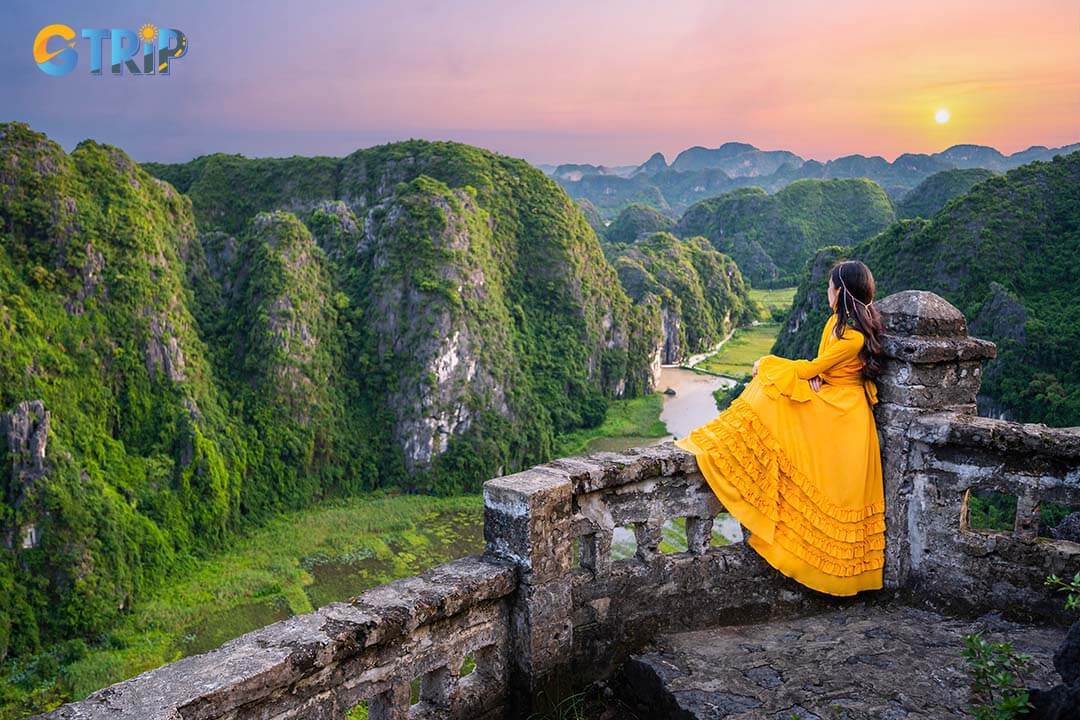
Cai Ha Mountain will give you a super beautiful scene for beautiful photos
Ky Lan Mountain
Situated in the heart of Ninh Binh, Ky Lan Mountain is one of the Four Great Mountains of the area, with a distinct shape resembling a majestic qilin amid the verdant scenery. The mountain attracts you with its diverse ecosystem and picturesque landscapes, featuring ancient trees, shaded by lush foliage and a serene lake, creating a calm, refreshing environment. It is ideal for reconnecting with nature and enjoying the fresh mountain air.
In addition to its natural beauty, Ky Lan Mountain holds cultural significance, with folklore linking it to Ninh Binh’s history. Upon reaching the mountain’s peak, travelers can take a panoramic view of Ninh Binh City, including the famous nearby landmarks. Ky Lan Mountain provides a sense of relaxation and a glimpse into the local stories and culture, making it a must-visit destination for those interested in exploring Vietnamese heritage.
Kiem Linh Mountain
Kiem Linh Mountain, located in Gia Tien Commune, Gia Vien District, is a famous site within Ninh Binh’s collection of scenic spots. Surrounded by awe-inspiring nature, Kiem Linh Mountain is noted for its striking beauty and ties to the ancient cultural and historical heritage of Hoa Lu, the former capital. It is also home to the Temple of the Holy Ancestor, dedicated to the revered deity Cao Son, who holds an important role in local beliefs and is honored with frequent offerings by the people.
Climbing Kiem Linh Mountain, visitors can appreciate the peaceful surroundings and learn about the ancient legends connected with the mountain. From the summit, a sweeping view of layered mountains and green fields extends far and wide, showcasing a picturesque natural setting. Beyond being a scenic destination, Kiem Linh Mountain is a spiritual site, inviting visitors to connect with the historical and cultural heritage of Ninh Binh.
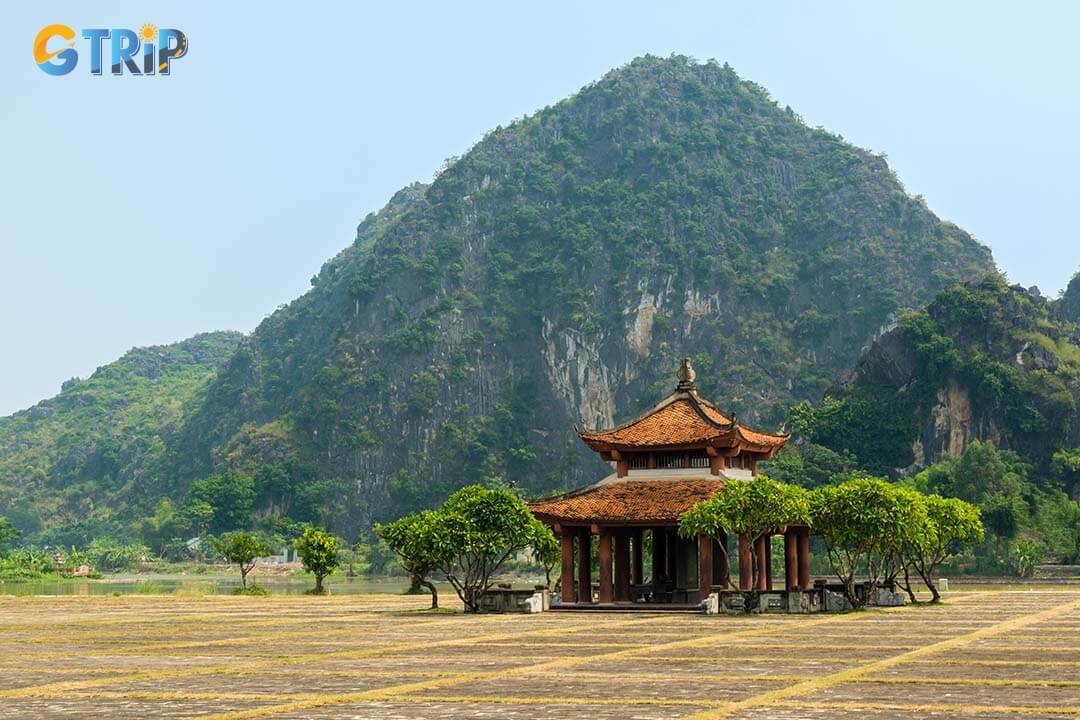
Kiem Linh Mountain
How to get to Hoa Lu Ancient Capital
Hoa Lu Ancient Capital is easily accessible from major cities like Hanoi. Here’s a guide on how to reach Hoa Lu.
You can explore more options in moving from Hanoi to Ninh Binh before making the right decision
1. By bus:
Traveling by bus from Hanoi to Hoa Lu is economical and efficient, with several daily departures. Notable bus companies include Hoang Long, offering comfortable sleeper buses for travelers seeking a restful journey.
- Vehicle type: 39-seat sleeper with modern amenities.
- Departure time in Hanoi: 9:30 p.m. daily.
- Travel time: Approximately 2.5 to 3 hours (subject to traffic).
- Departure Point: No. 1 Ngoc Hoi – Nuoc Ngam Bus Station, Hanoi.
- Destination: Forest and Sea Agency, No. 2 Tran Hung Dao, Ninh Binh.
Additional information
- Other pickup points are Giap Bat Bus Station (Hanoi) and Ninh Binh Bus Station (Ninh Binh).
- Ticket booking: It’s convenient to book tickets online through platforms like vexere.com where you can choose seats and view schedules.
2. By car or motorbike
For a more flexible journey, renting a private car or motorbike allows you to explore at your own pace.
- Route directions: Follow Highway 1A from Hanoi toward Ninh Binh, a straightforward, convenient route for car and motorbike travelers. This road is well-marked and offers scenic countryside views along the way.
- Travel time: The journey typically takes 2 – 2.5 hours by car, depending on traffic. For motorbikes, expect a slightly longer travel time, as it’s best to go at a moderate speed for safety.
- Fuel costs and tolls: Estimated fuel costs are around 150,000 VND for a one-way trip by car. Some sections of the route include tolls, so have some cash ready for convenience.
- Safety tips: Motorbike riders should wear helmets and carry essential documents. It’s wise to plan for regular breaks if traveling long-distance, mainly if you’re not accustomed to longer road trips.

Taxi from Hanoi to Hoa Lu
3. By train
Traveling by train from Hanoi to Ninh Binh City, you will move one more distance to reach Hoa Lu. The journey is an excellent choice for scenic views of the mountainous regions of Ninh Binh. Hanoi offers multiple trains daily to Ninh Binh, where you can easily reach Hoa Lu.
| Train | Departure from Hanoi | Arrival in Ninh Binh |
| SE7 | 06:10 | 08:23 |
| SE5 | 15:30 | 17:43 |
| SE3 | 19:20 | 21:31 |
| SE19 | 19:40 | 21:48 |
| SE1 | 20:55 | 23:07 |
Ticket booking: Tickets can be booked online through official sites like vietnamtraintickets.vn
What is the best means of transport from Hanoi to Hoa Lu?
Discovering Hoa Lu’s ancient capital is an unforgettable journey. Here’s how to choose the best way to get there, tailored to your travel style.
For comfort and freedom
Traveling to Hoa Lu by private car or motorbike is an excellent choice for those who prefer flexibility and independence. Private vehicles allow travelers to explore the historic capital of Hoa Lu and other nearby attractions at their own pace, without the constraints of scheduled tours or public transit. This option allows you to make stops and enjoy the scenic beauty.
For scenic view
Taking the train offers a more relaxed journey, perfect for travelers who want to enjoy the picturesque landscapes en route to Hoa Lu. While the train doesn’t take you directly to Hoa Lu, nearby Ninh Binh station is just a short drive from the ancient capital. This journey allows passengers to unwind and enjoy views of the stunning limestone mountains that define this region.
For budget-friendly travel
For those traveling on a budget, the bus is a convenient and affordable option to reach Hoa Lu. With frequent services from Hanoi to Ninh Binh, buses offer a budget-friendly way to achieve this historic site. Many buses stop in the main town, making it easy to transfer to Hoa Lu and explore the ancient landmarks and cultural heritage without overspending.
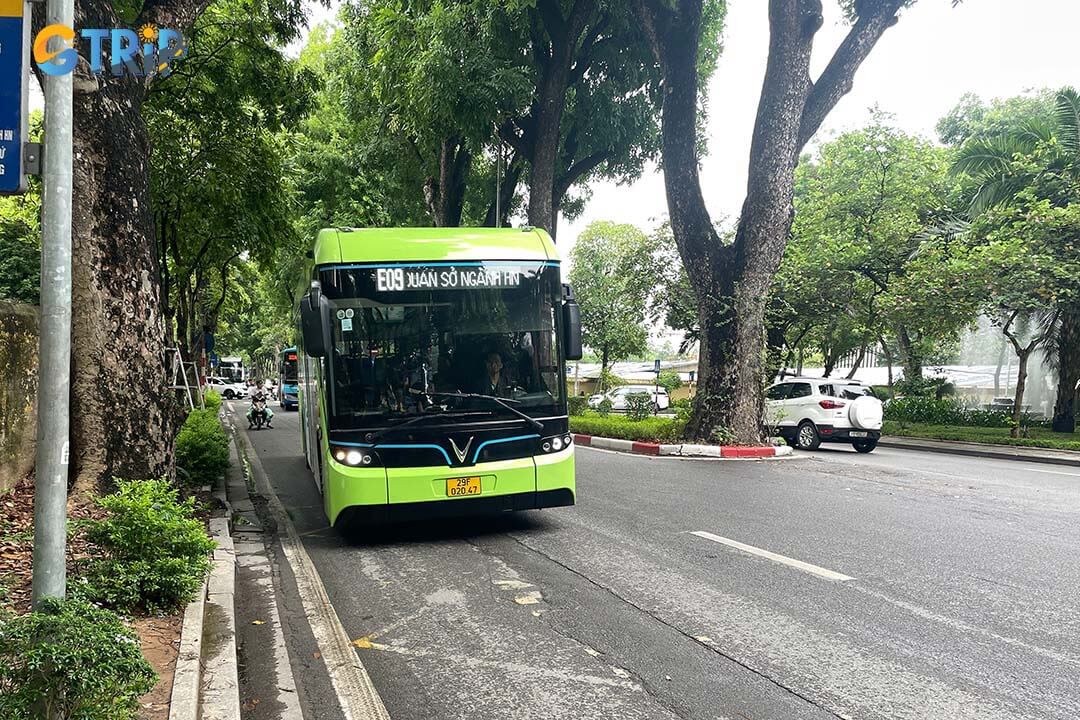
Traveling from Hanoi to Ninh Binh by bus
Tips for visiting Hoa Lu Ancient Capital
Hoa Lu Ancient Capital is a significant cultural and historical site in Northern Vietnam. Here are some practical tips to help you make the most of your visit.
1. Entrance fees, opening hours, and guided tours
- Entrance fee: The entrance fee is typically around 20,000 VND (approximately $1).
- Opening hours: Daily from 7:00 a.m. to 5:30 p.m.
- Guided tours: Hiring a local guide is recommended to gain insights into the site’s rich history. Some package tours to Ninh Binh include Hoa Lu in their itineraries and provide a knowledgeable guide.
2. Best time to visit and recommended duration
- Ideal season: Spring (February to April) is considered the best time to visit, especially after the Lunar New Year when many traditional festivals take place, adding to the experience. The vibrant atmosphere during this season enhances the cultural significance of Hoa Lu, making your visit even more enriching.
- Recommended duration: Allow at least 1-2 hours to explore the temples and scenic surroundings, and up to half a day if you plan to combine the visit with other nearby attractions like Tam Coc or Trang An. This allows ample time to soak in the historical essence of the area and enjoy the breathtaking landscapes of Ninh Binh.
3. What to wear and pack
- Clothing: Dress comfortably and respectfully, as Hoa Lu is a cultural and religious site. Light, breathable clothing is best, with comfortable walking shoes. Avoid wearing shorts or revealing tops to show respect for the local customs and traditions.
- Essentials: Bring a hat, sunscreen, and water, especially during the warmer months. A raincoat or umbrella is helpful in sudden rain showers, every day during the summer. Additionally, consider packing a small backpack to keep your belongings organized and easily accessible while you explore the area.
4. Local food and specialties to try
Exploring the local cuisine is a must to experience the authentic flavors of this culturally rich region.
- Mountain snail: A seasonal delicacy with a firm texture, often stir-fried with lemongrass or ginger. This dish is not only flavorful but also showcases the local cooking techniques that bring out the freshness of the ingredients.
- Mountain goat: The region’s most famous dish, served in various styles – grilled, steamed, or hot pot – with a savory, distinctive taste. It’s a favorite among visitors and locals, offering a unique taste of Ninh Binh’s mountainous terrain.
There are also many other specialties in Ninh Binh that you can try when traveling here.

A boat trip at Trang An near Hoa Lu Ancient Capital
Hoa Lu Ancient Capital in modern times
The Hoa Lu Ancient Capital is vital in Vietnam’s historical narrative and continues to thrive in modern times. Here are some insights into its preservation and cultural significance.
- Preservation efforts
Efforts to preserve and restore the ancient capital are ongoing, ensuring that the historical sites remain intact for future generations. These initiatives include renovations of ancient temples and structures and establishing protective regulations to safeguard the area’s cultural heritage.
- Cultural significance and tourist destination
The role of Hoa Lu in Vietnamese heritage is significant, as it symbolizes the rich history and traditions of the nation. As a popular tourist destination, it attracts you for its historical relevance and stunning landscapes, making it a vital part of Ninh Binh’s tourism economy.
- Annual festivals
Hoa Lu continues to celebrate its rich history through various annual festivals, including the Hoa Lu Festival, which honors the kings of the Dinh and early Le dynasties. These events draw crowds nationwide, fostering a strong community and cultural pride. They offer a chance to experience traditional customs and performances passed down through generations.
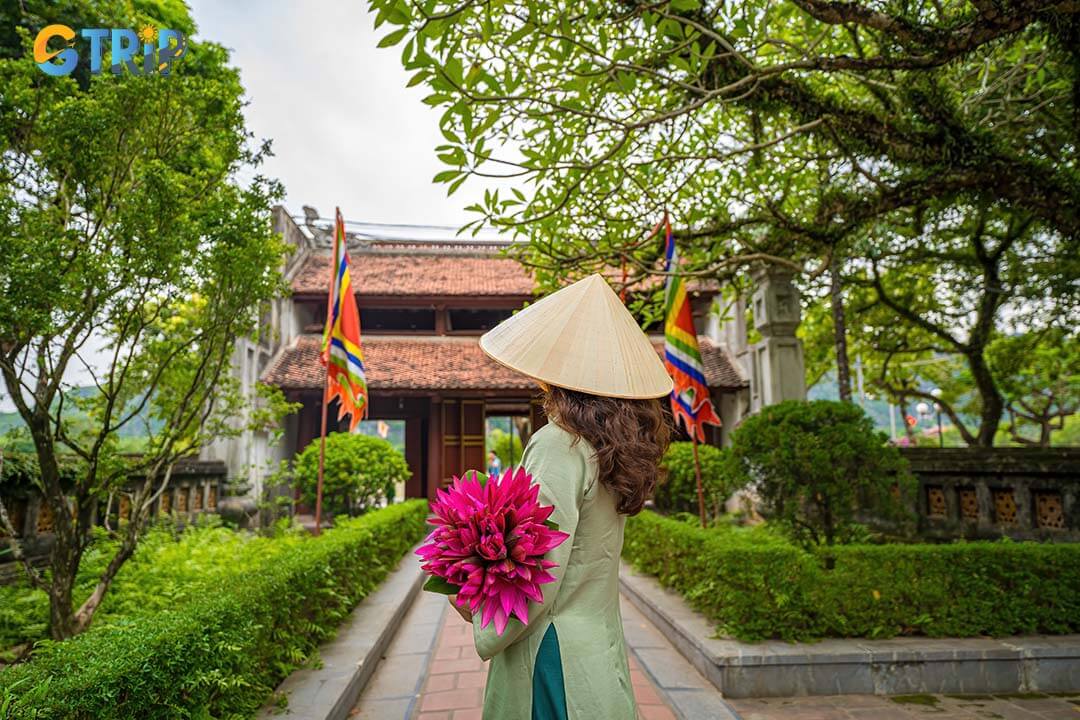
Back view of girl wearing ao dai in front of Hoa Lu Temples
Why visit Hoa Lu Ancient Capital
Visiting Hoa Lu Ancient Capital offers a unique opportunity to delve into Vietnam’s rich cultural heritage and historical significance. Here are the key reasons to consider this destination:
- Cultural and historical legacy: Hoa Lu is a testament to Vietnam’s storied past, serving as the capital during the Dinh and early Le dynasties. Its well-preserved temples and structures provide insights into ancient Vietnam’s architectural styles and religious practices.
- Historical importance: The site is of great historical significance, representing the origins of Vietnamese statehood and governance. It holds significant artifacts and monuments reflecting the country’s evolution through centuries, making it essential to understand Vietnam’s national identity.
- A unique blend of natural beauty and cultural heritage: Surrounded by breathtaking landscapes, limestone mountains, and lush rice paddies, Hoa Lu combines natural beauty with rich cultural experiences. Visitors can appreciate the serene environment and the vibrant historical sites in one location.
- Must-visit destination in Ninh Binh: Hoa Lu is a must-visit destination in Ninh Binh due to its accessibility, historical significance, and immersive experiences. Whether you are a history enthusiast, a nature lover, or a cultural explorer, Hoa Lu promises a memorable journey into the heart of Vietnam’s past.

Southern Citadel At Hoa Lu Acient Capital
In summary, Hoa Lu Ancient Capital offers a unique blend of cultural heritage and historical importance. From its rich history as Vietnam’s first capital to its stunning natural landscapes, Hoa Lu is a must-visit destination in Ninh Binh. Anyone seeking to immerse themselves in Vietnam’s history will find countless reasons to explore this remarkable site. Hoa Lu captivates visitors with its architectural splendor, vibrant festivals, and unique local traditions.




